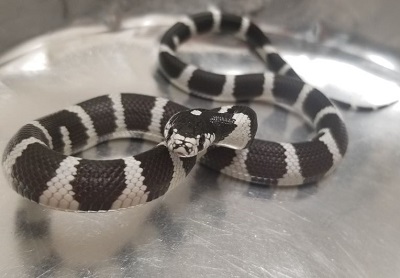
We had royalty as our latest Animal of the Month! But now that it’s the last day of August, it’s time to bid the California kingsnake a fond farewell as he slithers out of the spotlight. We hope you enjoyed following us @ExoticPetVets on Twitter as we tweeted fun and fascinating facts all month long about the California kingsnake. But if you missed any of our tweets, here is a summary that you can reference any time. Did you know?:
- It should come as no surprise that the California kingsnake (Lampropeltis californiae) is found in the state of California.
- But the California kingsnake is also found in areas surrounding California; including parts of Orgeon, New Mexico, Nevada, Arizona, Colorado, Utah and northern Mexico.
- In the wild, California kingsnakes can be found in a wide variety of habitats; including grasslands, shrublands, woodlands, wetlands, forests, savannas, deserts, rocky environments and suburban areas.
- There is a feral California kingsnake population on Gran Canaria, the third-largest island within Spain’s Canary Islands.
- California kingsnakes were first imported onto Gran Canaria as part of the pet trade in 1998. They have since become an invasive species as a result of escaped pets or pets who were deliberately released into the wild.
- Feral California kingsnakes are having a devastating impact on Gran Canaria’s ecosystem because of their heavy predation of reptiles endemic to the island.
- A recent study found that in areas with established feral California kingsnake populations, the numbers of the Gran Canaria giant lizard have dropped by more than 90%, the Gran Canaria skink by more than 80% and the Boettger’s wall gecko by more than 50%.
- The researchers say these endemic reptiles play critical roles in seed dispersal, plant pollination and invertebrate population control on Gran Canaria so the feral California kingsnake population has ignited an unfolding ecological disaster.
- As is the case with all snakes, California kingsnakes are carnivorous. In addition to lizards, they eat rodents, frogs, eggs and other snakes – including each other!
- Because they are prone to cannibalism, California kingsnakes in captivity need to be housed separately in their own enclosures.
- Because California kingsnakes don’t have thick bodies and typically only weigh up to 3.3 lbs (1.5 kg), they appear deceptively much smaller than they really are.
- Adult California kingsnakes usually grow to a length of between 3 and 4 feet (0.9 – 1.2 metres).
- California kingsnakes have shiny scales that have a base colour of either brown or black. On top of that base colour, they have white, yellow or cream-coloured splotches, bands or stripes.
- The patterns, banding or striping in these contrasting colours visually break up the outline of the California kingsnakes’ bodies, which helps them hide from predators in the wild.
- Selective breeding of captive California kingsnakes has resulted in different colour morphs including lavender, high white, chocolate and albino.
- California kingsnakes spend most of their time on the ground. But they are proficient at climbing trees – and they can swim too!
- Wild California kingsnakes are considered to be diurnal, meaning they are mostly active during the day – this is especially the case in the spring and fall when daytime temperatures are more moderate.
- But during the hot summer months, California kingsnakes in the wild tend to take it easy during the day and become more active at night.
- During the winter months, California kingsnakes will head underground and enter a state called brumation, which is a hibernation-like state for reptiles.
- While brumating, California kingsnakes will become almost entirely inactive – with the exception of getting an occasional drink of water. But their metabolism slows to a crawl and they will not eat.
- California kingsnakes have a number of predators in the wild; including coyotes, raccoons, skunks, opossums, humans and birds of prey such as owls, hawks and eagles.
- When they feel threatened, California kingsnakes will try to drive away predators by hissing and vibrating their tails in order to mimic the sound of the venomous rattlesnake.
- California kingsnakes will also try to protect themselves by coiling into a ball in order to hide their heads. They may also emit a musky odour or excrete feces.
- There’s a reason why California kingsnakes are considered kings. If they fight with snakes of a similar or larger size, they’ll almost always win. They have extraordinary strength and immunity to rattlesnake venom. They usually eat their defeated opponents.
- California kingsnakes are constrictors and they not only put the squeeze on their prey, but also on their combat opponents.
- Researchers from the University of Louisiana at Lafayette studied three species of kingsnake (including the California kingsnake) and three species of rat snake to compare the strength between the species, all similarly sized.
- While using dead mice wired with pressure sensors, the researchers measured the constriction strength of 182 rat snakes and kingsnakes. They found that all three kingsnake species had stronger constriction than all three of the rat snake species in the study.
- The researchers observed that the kingsnakes coiled around their mice in a tight organized way that resembled a spring; whereas, the rat snakes were less organized – their coils looking more pretzel-like.
- The researchers suggest this difference in coil style could be a reason why kingsnakes are able to exert more pressure while they constrict their prey and adversaries.
- With proper care, the average lifespan of captive California kingsnakes is between 10 and 15 years. But they are capable of living more than 20 years.

